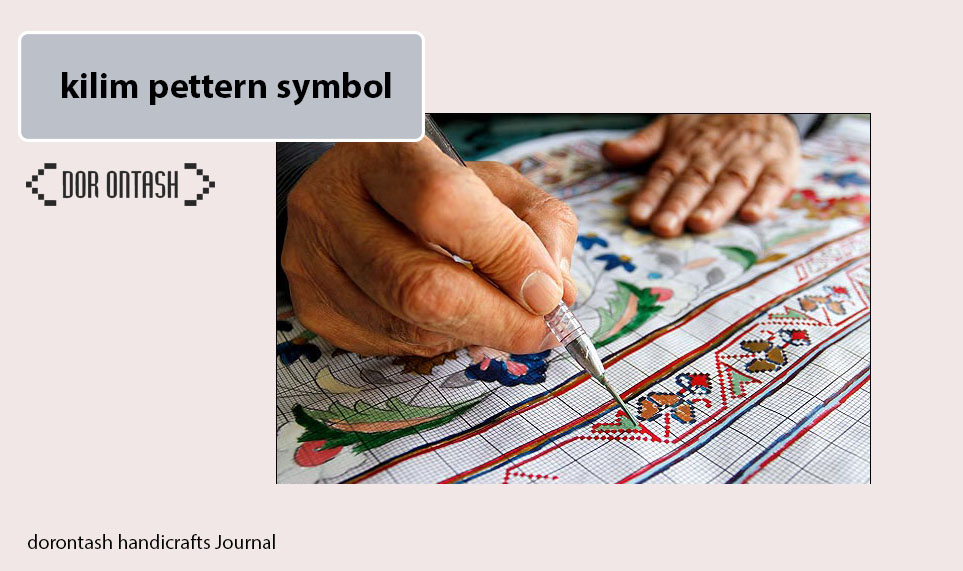The philosophy of local clothing
The diversity of Iran’s climate, along with customs and tribal ethnic cultures, has created different covers in all parts of the country. Coverings with special design and different colors, each of them alone can represent a part of Iran’s cultural diversity.
Unlike the urban communities that observe a single style in their clothing, the people of different regions of Iran have different patterns in dressing. A pattern that speaks of a certain philosophy and behind all its designs and colors, a large part of Iranian tradition, culture and identity can be found.
The philosophy of Iran’s local clothes is also defined in different places and according to the geography of the environment, age and age, celibacy or marriage, social position and position, clan and tribe, and similar cases. Inspired by their green and fresh nature, the people of northern Iran wear colorful and happy clothes. The people of the southern part of the country balance the heat of Sharjah by wearing thin and cool clothes. The clothing philosophy of the people of the desert region also has a strange harmony with the geography of their lives, and for this reason, they often go for white color so that it is easier to bear the dry heat of the desert region.
The people of mountainous areas and nomads use very loose pants to have more comfortable movement, and in cold areas, they wear woolen hats and scarves to protect themselves from the cold weather. In general, the philosophy of each of the local clothes of Iranian women and men is defined in accordance with their nature and lifestyle, as well as the cultural values of each nation.
Local clothes of Iran in the past
The clothes of the people of Iran, like many other parts of the world, were formed with the direct influence of environmental factors, the climate of the place of residence, religious beliefs and cultural beliefs, and in the course of time, they sometimes faced minor changes and developments.
The most important common feature of the clothes of Iranian peoples, especially the clothes of Iranian women in the past, was the variety of colors. The ancients of this land emphasized the use of colors in their clothes and believed that the color of clothes should create spiritual vitality. For this reason, the traditional women’s dress among the different ethnic groups of this land displays a festival of different colors.
Usually, the clothes were decorated with all kinds of decorative stitches, stones, beads, coins, and silk needlework to make it look attractive. In addition to beauty, the practicality of these clothes was always taken into consideration, and even nomadic women could easily do their daily tasks despite wearing long, loose and multi-layered clothes.
Some of these clothes have changed or faded over time and for various reasons; For example, sometimes using fabrics such as silk or decorations such as gold and silver in today’s traditional clothes is not affordable. Some of the arts of sewing and needlework of the past are outdated or forgotten or not compatible with newer tastes.
Over time, many people preferred to blend in with the society and local clothes joined the museum from the corner of the house or appeared only in special and ceremonial events; However, fortunately, some Iranian ethnic groups still insist on wearing their traditional clothes, as in the past, and pass on this original culture to the generations after them.
Local clothes of Iranian peoples
Azari clothes | iran clothes
The beautiful local dress of the people of Azerbaijan has long been a sign of their artistic, historical, ethnic and religious characteristics. A distinctive cover in which color takes the first place and decorations such as glabtone border embroidery, beading, pleating, etc. double its effect. In general, the three parts of headgear, bodysuit, and footgear make up the essence of Azari local clothing. The clothes that exist after the 20th century, only among the nomads and villagers in the past.
The fabrics used to make these clothes are usually made of silk, cashmere or velvet for women, and men’s clothes are often made of woolen fabrics. These fabrics can be changed based on people’s budget and financial ability, and they can be replaced with silk, taffeta, daryakanar, melmel, kudri, fastoni, ainagooli, utmasinar, motakgal, shalmooz and chit.
Azari women’s clothes | iran clothes
The color and type of fabrics used in sewing Azari clothes has a direct relationship with the age of people. Elderly women often use fabrics with simple and gentle designs and colors and little decorations. On the other hand, the clothes of Azari girls and young women have a pleasant variety of happy colors and beautiful patterns, and usually, more ornaments and decorations are used in it. Barak, Charqad, Yailiq, Kuink, Jabken, Arkalik or Arkhalikh are the main components of Azari women’s clothing.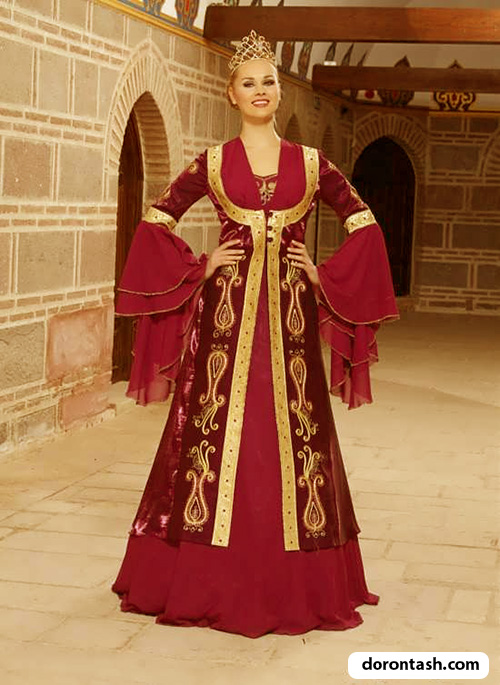
“Barak” is the name of a hat that can be seen on women’s heads either plainly or with colored sequins and decorative coins. These hats, along with vests decorated with coins, are often used among the rich and noble families. In the past, there was another hat called “Tas Kolah” in Azerbaijani tribes, which is rarely used now. This hat was decorated with colorful roots.
“Chargad” is a square cloth made of yarn or silk, which is folded diagonally and placed on the head. Usually, they choose bright colored fabrics for Chargad and large flowers make up its beautiful patterns. In fact, Charqad is the same scarf that some Azeri women cover their face with it in the chin area. The women of the Shahson tribe of Azerbaijan usually use flowered shawls to cover themselves.
“Yailiq” is a headscarf that old women wear on their foreheads to hold the charqad. Yaliq fabric usually has a red border and the middle is black. “Quinq” is considered the top of the dress that has no stitches and it is thrown open on the shoulder. The quinque is usually made of silk and is sewn with wide sleeves and no collar.
“Jabkan” is a dress that is worn over a quinque and is made of silk. Today, with the progress of the fashion industry, this cover has moved away from its traditional state; But the most important feature of Jabken in the past was very long sleeves with different shapes at the end, which were so-called from the shoulder to the bottom and covered the whole body.
“Arkalik” or Arkhalikh is a long and wide sleeve dress that is made of velvet and usually has a garlic crimson color and a pattern of different flowers. The sleeves of this dress are narrow up to the elbow and widen at the end with the help of pleats.
Women’s slippers also have different models, and socks, galesh (shoes without heels), charuq, qundara (a type of leather shoe), qirmizi bashmaq (slipper-like slippers) and takgun (celebration and wedding shoes) are among its types.
Azari men’s clothing | iran clothes
Azeri men’s clothes are often made of wool, and they wear headgear that is called “burk” or “papakh” in Turkish. There are different types of burkas, such as Dari Burka (leather hat), Pahlavi, Kopi, Kampa Burka (wool hat), brimmed, Keeche Burka (felt hat), straw, hybrid Burka (a type of lamb skin hat), Ergchin, Yun Burka (wool hat). ) and includes Shapo (Shapo).
Men’s bodysuits, like the women’s type, have different components, such as quinq, agh quinq (white shirt), bighob quinq, rubashaka, archalaq, satire, panje (a type of clothing like a coat), don or oima don, palton (coat), gime, kork It includes (skin), uvomashal (a kind of coat and pants) and pants.
Azeri men use lip chin or dolama (a kind of boots for cattlemen), tak goon, glase basmakh, charuq and choust for shoes.
Along with the discovery of hijab in 1314, the shape of men’s clothes also changed. Before that, during the Qajar period, a quinque or a white sleeved shirt with a round collar or diplomat, along with long coats called Arkhaliq or Bozmeli Dan and buffalo skin shoes called Charuq and Galesh, constituted the clothing of Azeri-speaking men.
During the Pahlavi period, this covering was changed to today’s jackets and pants, and instead of argchin and yunburk, which were made of sheep’s wool, they replaced a brimmed hat. However, still in special celebrations or rituals, Azeri men and women appear with the same beautiful traditional clothing to pass on the protection of their ancestral heritage to the next generations.
Kurdish dress | iran clothes
Kurdish clothing is one of the oldest and most diverse Iranian local clothing, which has a history as old as the Kurdish people of this land. In the first pictures showing Kurdish clothes, Achaemenid reliefs stand out. The men seen in the carvings at the entrance of the Apadana Palace are also wearing clothes similar to local Kurdish clothing.
The people of this area still use their traditional clothing on a daily basis and give themselves the gift of comfort and vitality at the same time. These clothes, like other local Iranian clothing, are made up of various components and apart from minor differences, they are very similar to each other. According to the region, Kurdish women’s and men’s clothes are also named as Orami, Saqzai, Marivani and similar titles.
He wore women’s clothes | iran clothes
Kurdish women’s clothing can be seen as a festival of different colors that showcases the glory of the mountains and the beauty of the plains at the same time. This cover is designed in two types, everyday and formal, and is sewn with silk, net, velvet and satin fabrics. The clothes are decorated with tapestry embroidery, bead embroidery, sequin embroidery, silver embroidery and stone embroidery, and the design of its fabrics is also very eye-catching.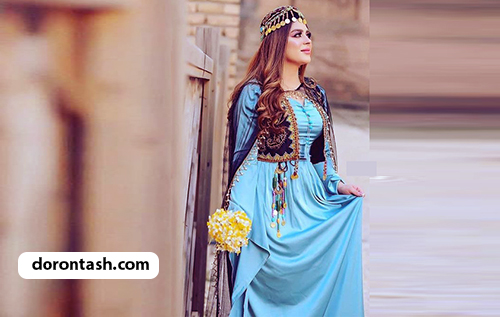
The traditional clothing of Kurdish women often has 11 different components, and shoes, pants, underwear, shirts, vests, Qoba, bodice or yale, ornamental three-cornered handkerchief, turban, scarf or sometimes a headscarf make up its general nature.
“Jafi” is a female Kurdish pant, which, like its male version, is wide at the top and narrows at the ankles. Soft and light fabrics are usually used to sew these pants; But its everyday type is different from the official one, and the official one is usually sewn from expensive fabrics. In some Kurdish regions, this pants is known as “Derpe” and it has a slight difference in the ankle area with Jafi; But the pants of Kurdish women of Kermanj (in the north of Khorasan) are designed in a different way (narrower than Jafi) and stick to the leg.
“Cross” is a long, wide, round-necked shirt with long sleeves and simple stitching, and several other pieces of clothing are worn on top of it. This dress is completely free and expands completely in the lower part of the body. For cross stitching, they often go for exquisite and expensive fabrics.
“Kalenje” or Sukhmeh is a waistcoat in the form of a vest that is worn over a long shirt. The kalanjeh is made of zaribaft or velvet fabric and gives it a more beautiful appearance with various decorative stitches. In the past, the means and the type of decoration of this vest showed the wealth of the family.
The velvet sleeveless bodice that Kurdish women wear in winter over Sukhmeh and cross is called “Salte”. “Kova” is a long, open-fronted velvet jacket with long slits, which is used by Kurdish women as a top.
Women wear “shawl” on their long shirts and in the waist area. This shawl is made of beautiful and flowery fabrics in a strip or square shape and has a variety of colors. The length of the shawl is estimated up to eight meters and its width up to 40 cm. Unlike men, women tie the shawl loosely around the waist so that the end of their long skirt does not go below the ankles and does not interfere with walking.
“Glooni” and in a more accurate pronunciation, “Glohnei” is a headscarf or scarf with special roles that Kurdish women wear in official situations and celebrations or mourning ceremonies. This cover is usually used among southern and Surani Kurds. “Lechak” also refers to a thin and triangular scarf that is attached to the hat with a pin and its three corners fall on the back and shoulders. Ornamental triangle or “dehsamal” is also a thin cloth embroidered with sequins that is worn in wedding ceremonies instead of a scarf.
“Klav” or hat is one of the other main components of Kurdish women’s clothing, which is actually a head covering consisting of a hat and a headscarf (servin) and it is available in two models, “Klaves” and “Klavzer”. This hat looks like a short cylinder and is embroidered with sequins. They also replace the hat with a scarf or a long scarf called “Kalke”, which wraps around the head and falls on the shoulder.
He wore men’s clothes | iran clothes
Kurdish men’s clothing consists of 9 pieces and components such as sweatpants, headbands, shirts, coats, vests, pants, socks, shoes, and waist scarves. This clothing is usually sewn loosely so that they don’t face any problem for moving through the mountains and difficult paths. Kurds believe that men’s heads should be covered, and for this reason, the types of hats and scarves in their clothing are considered a type of ancient culture.
Men’s Kurdish pants, which are known as “Demekopan”, “Patol” or “Rank”, are made of simple fabrics and usually in brown, dark brown and gray colors. These pants are quite wide in the upper part and it narrows when it reaches the ankles in order to prevent the cold from penetrating inside the pants in addition to being comfortable in mountainous areas. The waist of the pants has also been designed in a pleated (stretchy) fashion for more comfort.
“Yal”, “Chokheh” or “Kehwa” means a short torso and a short cover with long sleeves and worn by the rank. Chokheh is usually made of cotton or wool and according to the hot and cold seasons, it is sewn with thin or thick material. The high-quality type of this dress is produced from a type of goat hair known as “Morghoz” or “Me Rahez”, which is dedicated to parties and celebrations.
“Lefke Sorani” is a white and very long cloth with a triangular tab that is sewn at the end of the sleeve and is wrapped around the hand (from the elbow to the wrist). Kurdish men keep Surani hanging during weddings and celebrations and wave it like a long handkerchief during dancing.
“Waist Shawl” is a long and wide cotton cloth that is tied around the waist and over the torso and pants. This shawl is between 30 and 60 cm wide and its length sometimes reaches 20 meters. In fact, the length of the shawl will vary according to the men’s rank and status, and important personalities and elders of Kurdish tribes use longer shawls. Shawl can have different names such as “Pesht Win” and “Pesht Yeh” and the purpose of tying it is to keep the body warm.
“Kolebal” is a felt vest that is worn over clothes and protects the body from the cold. This part of Kurdish men’s clothing is mostly used by shepherds and they put it on the shoulder.
“Kelav” in the Kurdish language refers to a hat, which exists in two forms, long or flat, and in black and white colors. In the Kurdish hat, delicate designs can be seen and they are usually used together with “patch”. A patterned handkerchief or cloth that is tied around the hat and sometimes its strings hang over the face is also called “patch” or “patch”.
“Puzvaneh” or woolen leggings is a cover for the autumn and winter seasons, which is woven from wool. Leggings are usually used to protect the leg from snow moisture and extreme cold and are wrapped around the leg. This cover also helps the person to travel in mountainous and difficult areas without disturbing the wide part of the pants. Some believe that using this cover is also useful in summer and will prevent snake bites in this season.
“Klash” or giweh is the traditional shoe of Kurdish men, which is usually white or milky in color. The sewing of these slippers is done entirely by hand using carpet yarn, and leather is used for the sole. This traditional footmuff keeps the feet cool and prevents bad odor. But for this reason, it is not suitable for cold seasons and rainy season.
Larry’s dress | iran clothes
The Ler people are known as one of the most authentic Iranian peoples, who divide them into two groups, the large and small Ler groups. The great Bakhtiari clan, Mamsani and Boyer Ahmadi clans are known as “Big Ler” and the people of today’s Lorestan and parts of Hamedan and Ilam are known as “Little Ler”. The local dress of both groups is generally the same and only small differences can be seen in different tribes.
The coexistence of Ler-speaking people with nature (like other Iranian peoples) and the geographical features of their climate plays an important and decisive role in the design of the traditional clothes of this people. These clothes are divided into two general categories: Lori Fili local clothes and Bakhtiari local clothes. Lori Fili is the special dress of Lorestan, Hamedan and Ilam regions, and Bakhtiari local dress, as its name suggests, is dedicated to the Bakhtiari nomads, whose territory is west of Isfahan, east of Lorestan, and east, northeast, and southeast of Khuzestan. The Lori costume of Kohgiluyeh and Boyer Ahmad provinces was also registered in the national register in June 2017.
Lor women’s clothing | iran clothes
Climatic conditions on one hand and need on the other hand determined the design of Lorestan women’s clothing. Changing the color of the cloths of Lor women’s clothing indicates social status, age and other similar things. Therefore, older women wear dark colored cloths with simple designs and black and white headbands, and young women wear cheerful and colorful clothes. The cap, tunic, top, and shoes are the main components of this local dress.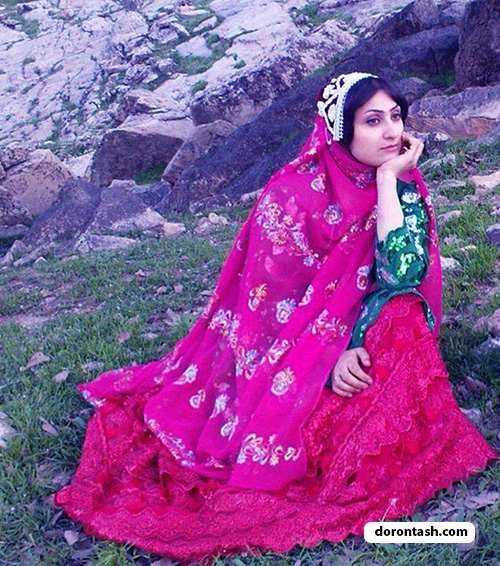
“Seron” or headscarf is actually the same charqad worn by Ler women; so that only part of the head hair is covered and the hair hangs from the side of the ears on the shoulder. In the past, the front part of Seron was decorated with exquisite and beautiful beads and pieces of gold and silver, but nowadays these expensive decorative stones have been replaced with fake ornaments. Ler women use colored headscarves in weddings and celebrations, and black headscarves in times of mourning, which sometimes reach the back of the knee.
“Golvani” is another authentic headband that resembles a scarf and is estimated to be 3000 years old. This kind of beautiful headband, which is known as a symbol of the Ler people, is usually seen on women’s heads during happy ceremonies, and old men used to wrap a gloni around the Ler hat (show hat) during parties and wars. This scarf is woven from silk and decorated with traditional patterns. Color is determined based on people’s age; For this reason, you will usually see dark colored fabrics with simple designs and black and white headbands on the heads of older women. This type of covering was registered as one of the heritages of the Lor people in 2017, and the 26th of May has been named as “Lori Scarf Day” in the calendar.
“Tare” or “Saveh” is the third type of Lori scarf, which Lori women wear on normal days and decorate this charqad with glitter during celebrations. “Coat” is also a simple and large charqadi with colored and rooted borders, which is made of silk or silk, and decorative coins double its beauty.
“Arakchen” is also considered as a type of Lori headband, and in fact, it is a hat made of velvet and a piece of cloth. Ler women put this hat on their head so that it doesn’t slip off their head and completes their cover in terms of beauty.
“Kras” or “Jummeh” is the main clothing of women and a long and simple shirt with a round collar and wide sleeves. There are cuts or slits on the upper body and sides of the dress that make it easy for the person to move, and the skirt of this shirt is wider with the help of the cut. They also add a rhombus-shaped bird called “Sicheh” in the armpit of the dress for more comfort. Crepe velvet, shawl, gold, satin and floral are the types of fabrics that are used for cross stitching and according to the occasion the dress is used for. Bal-Kel, mane, kalanja, vest and koqlanja are also worn as a cross top.
“Bal Kel” which is known as “Sardari” in some regions of Lorestan, is considered a traditional top. Austin is called “wing” in Lori, and “whole” means short; Therefore, the entire skirt is a short-sleeved dress. The height of this dress reaches to the knee, and its material is usually considered velvet, and the sleeve part is decorated with “karmakdozi”.
“Yal” and “coat” are two other coverings for the upper body in the form of a short coat. A bodice that closes in front with a button, unlike a vest, is called a coat. The mane is also sewn from velvet fabric, and like other Ler women’s clothes, old people use black or dark red mane and young women use red mane in their clothing.
“Kalanja” is a light-colored velvet bodice decorated with decorative coins and has embroidery around the sleeves. “Vest” or Jalizeh is also a sleeveless and open front bodice, which is also decorated with coins and yazak embroidery. “Kuqlanja” is another upper garment for Ler women, which is sewn from gold or velvet and worn over the crotch.
“Shawal” is the pants that are sewn from colored fabrics similar to Kurdish pants; With the difference that Lor women’s pants are sewn in two pieces. They use simple fabric from the hem of the pants to the top of the knee and give it a beautiful look with embroidery, needlework and patterning. For the upper part of the pants, they go for a different colored floral fabric. For special ceremonies and parties, they also wear velvet shawls.
“Ajih” or “Ajideh” is a women’s shoe, and in fact, it is a garment that is woven by women themselves. Lor women’s clothes have more designs than men’s clothes. Its fibers are made of wool and its sole is considered to be made of leather.
Lor men’s clothing | iran clothes
The men’s Lori dress is designed more simply than the women’s type, and at the same time, it looks beautiful and magnificent. This type of local clothing includes a felt hat with a headband, shirt, pants, satire, shawl, giweh and shula (for shepherds).
“Felt hat” as its name implies, is woven from felt and its length can be approximately 25 to 28 cm. The color of this hat is usually black and it is sewn round and without a brim.
Ler men’s “shirts” have been designed in the utmost simplicity with regular cuts and straight or short sleeves. “Shawal” or the same pants, like Kurdish pants, is wide and completely free from the thighs, and is pleated with pleats at the waist. This type of pants is often seen in black.
“Streh” is one of the oldest types of Iranian clothing and is used by Ler men in official ceremonies. This cover is actually a special open front cover that is closed by wrapping the shawl. The length of this Lori local dress reaches the knee and the fabric used can be plain or patterned.
“Shawl” is a long white cloth made of chelwar, 6 to 9 meters long and 60 to 90 cm wide. The shawl is wrapped on the shirt or top and several times around the waist to give a better appearance to the cover. This cloth is also used in emergency situations as a rope or to bind an injured limb when a part of the body is injured.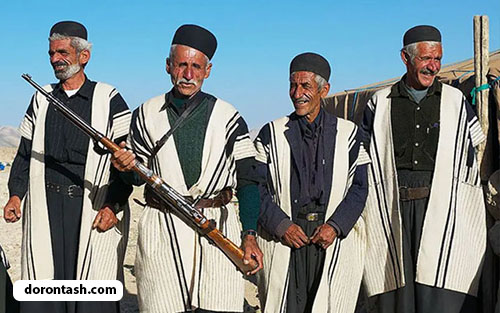
“Shula” is made of thick woven and sleeveless fabric and this long cover is worn over the clothes. “Kepnak” or “Farji” is also considered a type of strong woolen blanket used by shepherds.
“Chogha” or “Chogha” is another Lori men’s top which is made of sheep’s wool and is woven by Bakhtiari women. This dress is mostly used in Bakhtiari region of Lorestan, Chaharmahal and Bakhtiari. Chogha is considered one of the most famous tops for men, which has a combination of black and white colors.
“Giveh” is the same handmade and local shoe that is produced with a woven upper and a leather or thick plastic sole.
Abyaneh dress | iran clothes
The traditional clothes of Abyaneh people are among the attractions of this beautiful historical village. A dress that is still popular among its inhabitants and they show their self-assertion and prejudice in protecting this heritage. The loose black pants of the men and the colorful dresses of the Abianeh women show a beautiful combination of the climate of this village and the culture of its people. Abyaneh traditional dress has been registered as an intangible cultural heritage of the country in the list of national works of Iran.
Abyaneh women’s clothing | iran clothes
Abyaneh women’s clothes are very similar to Safavid era women’s clothes. This outfit includes colorful shirts with knee-length skirts, pleated skirts called shaliteh, and charqads with a white background and various floral designs. The traditional dress of Abianeh is attributed to thousands of years ago, and its main characteristic (like most traditional Iranian dresses) is the use of bright and eye-catching colors. The clothes of older women are simpler and the clothes of young women are seen with more decorations; But these women do not appear in black clothes even in mourning ceremonies.
The “shirt” of Abyaneh women, which reaches above the knee, is straight and wide, and they have designed it with a round collar and no wrists. This shirt has cuts on the left and right sides (about 10 cm below the waist) that are sewn around it with a different fabric, the front chest. On the chest and on both sides of the cut, they decorate with various bands or fittings. Colorful fabrics are sewn together in the form of two-layered triangles next to the strips and along the cut, and the hem of the shirt is also decorated with needlework. In the past, the material of this dress was taffeta and its color was juniper and blue; But today it is produced in different materials and colors.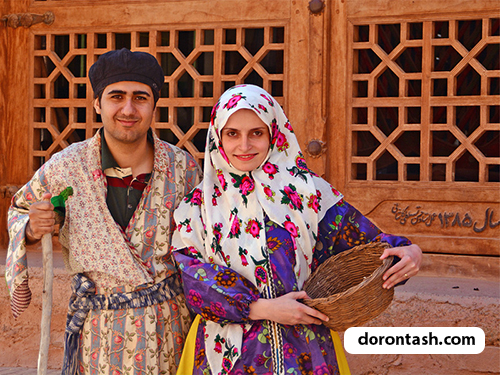
“Shelite” is a pleated skirt with seven to eight meters of fabric used in its sewing. The material of this type of wide trousers is chosen from motagal or dyed canvas or cotton fabrics with flowers. The waist of the skirt is gathered with a strap or an elastic band, and two or more rows of embroidery or embroidery in the middle of the length and the skirt gives a beautiful appearance to this cover.
“Yel” is a straight coat whose length reaches about the thighs and its sleeves reach the wrists. This cover has a slit in the armpit, and the collar is sewn with two rows of tape embroidery. Ancient people used taffeta fabric for wool; But nowadays, cashmere is usually used to sew this traditional cover.
“Churqad”, the charqad or scarf of Abyaneh women, is also a flowery fabric with a white background and a square shape. This 1.5 x 1.5 meter square is folded into triangles and placed on the head.
“Sarband” is a black cloth that is used to keep the scarf stable. This cloth is tied on the forehead from the front of the head and tied in a ring at the back of the head.
“Arakchin” is a bowl-like hat, usually red, that is worn under the charqad; so that some of it is clear from below This hat is decorated with silver and other ornaments in wedding ceremonies.
Abyaneh women’s “footwear” is different in the two seasons of the year, cold and hot. “Giveh” will be the cool summer slippers and “Chemosh” will be the shoes of the cold seasons and the rainy season.
“Chadershab” or “Kaji” in the local language, is a square silk cloth with dimensions of 2×2 meters and with a checkered design, which is woven by Abyaneh women. This tent is tied around the waist or placed on the head. The color of Chadorshab also suits the age of women and usually young girls use yellow and old women use red.
Abyaneh men’s clothing | iran clothes
The clothing of Abianeh men, especially the loose pants they wear, is very similar to the clothing of Il Bakhtiari. Therefore, some attribute the origin of the previous residents of this village to the Bakhtiari people. Abianeh men’s clothing consists of components such as shirts, temons, qabas, hats, shawls and scarves.
Abyaneh men’s “shirt” changes according to the season and weather conditions. This shirt is usually round-necked and its lower part is similar to the men’s shirts of Gilan and Mazandaran.
“Tamon” is the same as Abianeh’s men’s trousers, which are long, black in color, have a waist and are designed with two wide legs (the width of the soles reaches 90-100 cm). The decorations on the bottom of the pants show whether people are married or single; So that diamond-shaped embroidery is sewn for single people and smooth lines around the legs for married people.
“Qaba” is, in fact, a coat-like garment that has slits on both sides, and the pocket is placed above the slit, and the pocket bag is secretly sewn under the quba. Qaba has a left and right collar and it is sewn from colored and striped fabrics. A triangular cloth is also sewn on the sides of the Qoba so that the skirt of the Qoba becomes wider and the two sides overlap more.
“Al-Khulq” or “Arkhalq” was mostly used for men in higher social classes. This cover helps to stabilize the body more.
The “waist shawl” of Abyaneh men is often milky colored and hand-woven by the women artists of this region. This shawl is tied on the back and around the waist. Their “hat” is also made of felt and is produced in a short and round shape, and usually their “shoes” are also hand-woven by themselves.
Continue the article in iran Traditional clothes – division 2

